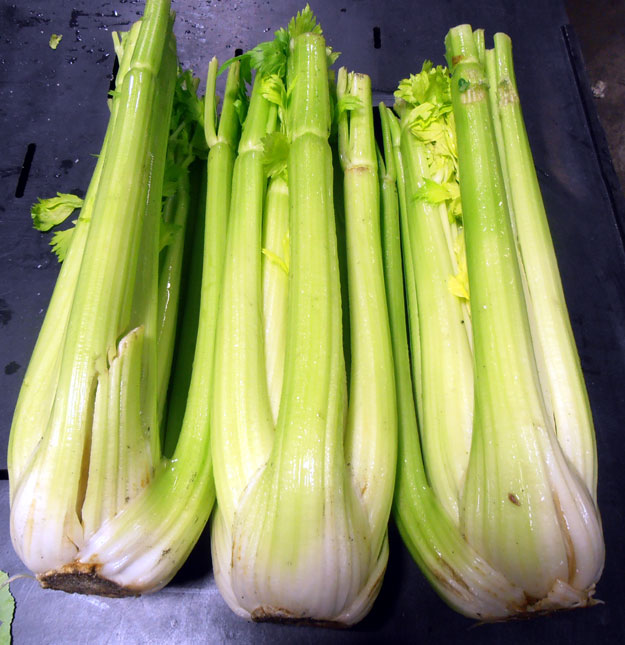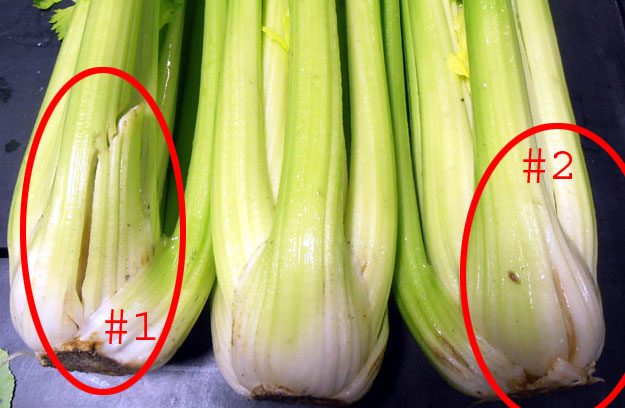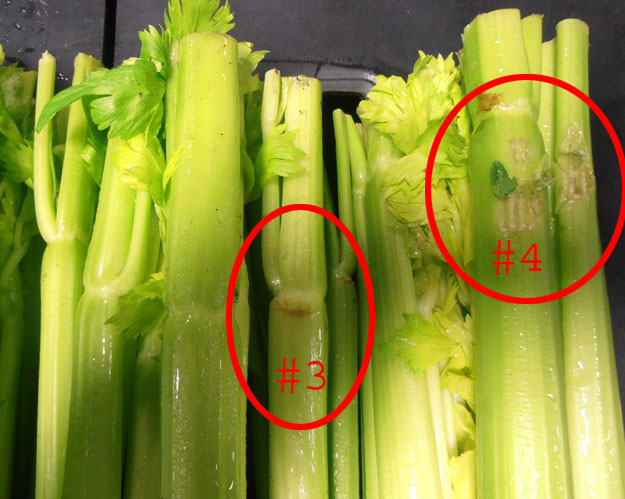For this post I’ll let you tell me the name of the following defects pictured below. There are three different defects shown here, or technically four different defects. Can you identify them?

These three stalks of celery came from one bag of celery hearts. Not to confuse you, but these defects shown here are not scorable defects, meaning they would not be scored as defects against the U.S. No. 1 Grade.

Towards the butt, or bottom of the celery you can find two defects. On the left, or Defect #1, is caused from bruising. During the packing, or transport process the outer branch was injured, causing the cracking or bruised stalk. If you found more than 2 branches with bruising (meaning you would have to find bruising, like this, on at least 3 branches) then the stalk would be scored as a defect, a very liberal scoring guideline.
The celery stalk on the right, or Defect #2 is not bruising. It looks very similar to defect #1 but this split is not caused my rough handling, but happened when the celery was growing. Defect #2 is an example of a growth crack, a vertical growth crack specifically. Rapid growth by the celery is thought to be the cause of this defect. The scoring guideline for vertical growth crack is; “When more than 2 branches are affected by growth cracks which are over one-half inch in length, or when more than 6 branches have growth cracks.” Yes, that is what the USDA says, if you find growth cracks on more than 6 branches it can be scored as a defect……again, a very liberal scoring guideline. (Do celery hearts even have 7 branches???)

Let’s take a look at the top of the picture. The middle celery stalk, or Defect #3 is another type of growth crack, called a horizontal growth crack. Horizontal cracks are often found on the midribs of branches. Can you guess the USDA scoring guideline? “Horizontal cracks are scored as a defect (damage) when more than 3 branches have horizontal cracks which are over one-half inch in length, or when more than 6 branches have horizontal cracks.” Have you ever found horizontal growth cracks on 7 or more branches? I didn’t think so.
Now how about the final defect, Defect #4? This defect is called scuffing. Similar to bruising, scuffing of the branches followed by discoloration sometimes occurs due to rough handling. It appears as flattened, discolored, or bruised areas on the outer midribs as a result of rubbing or pressure. This condition is often not readily apparent at time of packing, but may later show discoloration ranging from gray to black. Scuffing is also a defect found on summer squash, where the surface appears roughed up, or slightly bruised. The USDA does not find this defect objectionable either, as their scoring guideline is; “Score as damage when more than 2 branches are materially scuffed or bruised so that the appearance of the stalk is damaged.”
I do have one last point to make. Because the celery stalk on the right is showing 2 defects, the growth crack near the butt of the stalk and the scuffing near the top, I would score this stalk as a defect, because of the combination of defects materially affecting the appearance. If the package of celery hearts contained these three stalks, and one of these was scored as a defect, I would report 33% defects for this sample, and I would call the defect “scuffing”, a condition defect. Do you agree?

3 Comments on “Celery Defects”
Hey There. I found your blog using msn. This is a very well written article.
I will be sure to bookmark it and come back to read more of your useful info.
Thanks for the post. I will certainly comeback.
Hi,
What is the surface that should be considered sufficient to score “scuffing”? 1 square inch per branche on more than 2 branches? 1 square inch in the aggregate per stalk (as long as there’s more than two branches affected)?
Thanks
Ippgadget,
Excellent question concerning how big of an area of scuffing is allowed on more than two branches. It is because of these subjective USDA guidelines that many inspectors (USDA included) become frustrated, and uniformity becomes a problem. The USDA has no defined area, other than to say when the scuffing materially detracts from the appearance of more than two branches. I think using a 1 inch guideline for scuffing on three branches is a good guideline, but if the scuffing is rough and ragged, as shown as Defect #4 above, I would use a guideline of 1/2 inch on three branches. Looking at Defect #4, I would say the scuffing is enough on those two branches to be considered as materially affecting the appearance, so you would need one more branch to score the stalk as a defect, damage by scuffing.